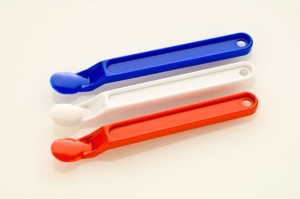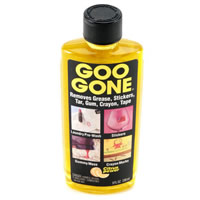Find yourself in a bit of a sticky situation? All gummed up with nowhere to go! Yes, you’ve guessed correctly, it’s an article about the glamorous and exciting world of label removal.
Our store has a reputation for having clean and very gently used books. This is largely due to the beautifying ritual that we put them through. Each book that comes through our doors is examined for any possible flaw that we could improve, and any that need work are set aside to have the necessary treatments applied to them. One of the most glaring flaws is old labels.
At The Book Man, we have a strict label removal policy – we always remove labels from other bookstores, thrift shops and the like. It not only helps us present all books in their best possible condition – it also shields both customers and staff from unpleasant conversations involving price discrepancies.
We set aside all books with labels, or label residue on them, and tackle them all at once. This enables us to set up your work station, don gloves, and save time by doing a mass soak & remove cycle. Our tools for the job include disposable surgical gloves, cotton pads (preferably with a “scrubby/rough” side – dollar stores are great for cheap ones), Kleenex, Goo Gone, a pen knife, our thumb-nails, and our Scotty Peelers.
Some labels can be removed without much effort at all. Simply slide your thumbnail, Scotty Peeler or pen knife under the edge of a corner and peel. Getting a whole “side” of the label with your peeling tool often improves the likelihood of removal in one nice piece. We then distribute a tiny amount of Goo Gone on a cotton pad and rub off any residue. If not removed, this residue will still feel sticky, as well as attract dirt and grime over time.
Any books with label residue simply get a firm, circular scrubbing motion with a cotton pad and Goo Gone, and a swipe with a Kleenex to remove any extra product.

Now it’s time to spread out our books, offensive label side up (double-side offenders get put together in one area), put on our gloves, and load up a cotton pad with a healthy amount of Goo Gone. Soak all labels thoroughly with a gentle rub/press, and throw the soaked cotton pad out in a sealed garbage can.
Now leave the product to do its work, and go do something else for about ten minutes. You’ll be tempted to come back sooner, but trust me, it’s not worth it – impatience just leads to ripped covers.
Coming back, take out your pen knife, or one of your Scotty Peelers and work it under the corner/edge of the offending label, and then work it underneath and across until it gently peels off. Assuming that it’s a “nice label” all you’ll need to do is take a little Kleenex, perhaps another cotton pad with a TINY amount of goo gone on it, wipe off the residue, and your book is good to go.
Nasty labels require a little more patience (and depending on your personality type, perhaps a little more colourful language as well). Try to get the top off of particularly shiny labels, exposing their tender papery underbelly, which can easily be soaked with goo-gone and removed as per the above instructions. Some labels have a security feature (ie – they come apart in about ten little fragments, and leave a thick, greasy, sticky residue underneath). These have to be eked off – the Scotty Peelers are good for this, a strong thumbnail bit by bit. Patience and technique will usually get them off without marring the cover too much, then it’s just a matter of melting off the thick gooey residue they leave behind. More clean pads with more goo gone, swiping them with a tissue afterwards, and holding it up to the light to make sure it’s actually clean is the ticket there.
Very absorptive books (older paperbacks without that glossy finish, papery dustjackets, and the like) cannot handle Goo Gone. It will stain them. These require more love and care – peeling the labels off VERY slowly using your tools, sometimes a hairdryer set at high heat can loosen the gum as well.
 Goo Gone Warnings: I often throw caution to the wind (don’t tell my mother) and don’t wear gloves, but it is safer to wear them and not have contact with Goo Gone. Goo Gone, while effective, is also poisonous, so I always make sure that it is capped between usages, and that I don’t expose myself unnecessarily to its fumes. I have tried “natural” products that were much less poisonous but sadly, also much less effective. Goo gone has recently opted to “save money” by changing the distribution method on their bottles. Instead of a nice little plastic top with a tiny hole in the middle, they arrive with a skimpy piece of plastic covering the neck, which you are supposed to remove for use. These cause you to use way too much product. Luckily I had some old bottles, which I popped the tops out of and transfer into new bottles. You can get around this by putting a pin-hole in the new lids yourself, or by finding a more appropriate bottle and transferring the Goo Gone into that.
Goo Gone Warnings: I often throw caution to the wind (don’t tell my mother) and don’t wear gloves, but it is safer to wear them and not have contact with Goo Gone. Goo Gone, while effective, is also poisonous, so I always make sure that it is capped between usages, and that I don’t expose myself unnecessarily to its fumes. I have tried “natural” products that were much less poisonous but sadly, also much less effective. Goo gone has recently opted to “save money” by changing the distribution method on their bottles. Instead of a nice little plastic top with a tiny hole in the middle, they arrive with a skimpy piece of plastic covering the neck, which you are supposed to remove for use. These cause you to use way too much product. Luckily I had some old bottles, which I popped the tops out of and transfer into new bottles. You can get around this by putting a pin-hole in the new lids yourself, or by finding a more appropriate bottle and transferring the Goo Gone into that.

I have a less destructive, less messy method that is the absolute way to remove any kind of sticker from paper dust jackets.
No need for tools or cautious picking. I was taught this method by a antiquarian book collector and seller, it leaves no residue, does not stain, and evaporates immediately. No need to wait, it does the job right away.
The magical label remover is called Bestine. It comes in a 32 fl. oz aluminum can. It is a ‘solvent and thinner, for thinning or reducing rubber cement.”
You put a generous amount on a dry cloth, quickly close the can, and rub gently. Reapply if the first round doesn’t fully get it off.
I use this same thing for my jewelry-I use permanent photo mount and sometimes it gets on the image, which would make the piece useless, A little Bestine, and it’s gone.
I’m fairly certain it’s fine for paperbacks, glossy or no, because it evaporates extremely quickly. Try not to get any on your hands, and don’t breathe in the fumes for any length of time, it is powerful stuff.
Also, with practically anything, don’t have an open flame near it.
I have seen an ugly sticker on a first edition which would have lowered the value of the book considerably, removed in a few minutes as if it had never been. I’ve used it for lots of my books too, and nothing has been damaged.
Just another option.
I will definitely be picking some of this up. Toxicity is always a concern, but sometimes it’s necessary to get the job done – maybe I’ll do it outside.
Amber–so sorry, I just realized you wrote this, I’m not slow or anything, duh!
It really isn’t that toxic-you use it so quickly, it really doesn’t have time to be harmful.
I believe we bought it at art supply stores, but I’ll check to make sure where someone can find it–something I should added to the article!
Amber does a great job explaining her technique. I’d like to offer a slightly different approach using a lot less chemicals.
Keep in mind that 99% of all labels you find on book covers are nothing more than paper with a sticky adhesive undercoating. Getting them off of coated dust jackets and paperback covers is shockingly easy.
Just take a damp cloth (not dripping wet, but damp, and gently rub the label until the paper rubs off. Now all you’re left with is the adhesive.
Now pour a bit of GooGone on lint free cloth and wipe away the adhesive residue. You’re done in just a few minutes, easy as pie.
is it toxic? goo gone seems very useful when removing labels but it can be harmful for hands.